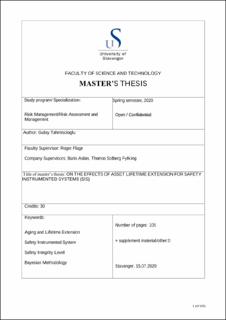| dc.description.abstract | A number of the offshore facilities in Norway have either been approaching their design life or exceeded them while there is still a considerable amount of oil and gas extractable in the field. Therefore, aging and life extension (ALE) has become a strong topic in Norway's offshore activities. The principals principles of aging and life extension activities have been addressed by numerous standards and implementation guidelines published in years. As offshore structures change with time (age), the question of how these changes could affect safety systems beyond their pre-defined useful lifetimes arises and becomes one of the crucial concerns for the offshore industries.
Safety Instrumented Systems (SISs) are critical to ensure optimal and compliant industrial operations due to their capability of preventing hazardous and catastrophic situations. They are formed of one or more Safety Instrumented Functions (SIFs) and designed to endure and work with critical processes with a low failure rate. It is a common practice to analyze their effectiveness based on specified failures rates of individual components of each SIF. The failure rates are treated both with generic failure rates and with plant-specific failure rates during the design and operation stages of facilities. Practically, the required risk reduction provided by SIFs must be ensured as long as the facility is in operational phases. In the recent past, it has been encountered that most of the components forming the SIFs have been used more longer than their originally stipulated useful lifetimes within the scope of ALE. This raises the question of whether the failure rates remain as expected or not throughout the extension period.
Although there are various studies in the literature addressing the behavior of components based on probability of failure while they are aged, none of them provides a computational estimation to re-quantify their Safety Integrity Levels (SILs) which is based on the estimated failure rates. The purpose of this thesis is to investigate the changes in failure rates of the components over time, thus the SILs of SIFs and safety of SISs, when their operation times exceed their pre-defined useful lifetimes. The estimations of failure rates are obtained by taking the expert knowledge about component failure rates and data on hand into account. For this purpose, Bayesian Methodology is generated and the model for failure rate estimation over time is created and implemented in this thesis. The discussion about whether the safety systems maintain the expected safety levels set by the national/international/company standards is presented based on the results of performed analysis.
The restricted time of this thesis does not allow analyzing the behavior of all prevalent safety systems throughout ALE period. For this reason, only 3 SISs (Emergency Shutdown Systems, Pressure Shutdown Systems (PSD), Fire & Gas Detection Systems) are chosen as the basis of this thesis. It is assumed that understanding the changing trend of failure rates for the most common SIFs belonging to these 3 SISs under aging and life extension will give overall insight about the performance of other SIFs and corresponding SISs in time. For this reason, High Pressure Protection System (HIPPS) from PSD SIS, Emergency Shutdown (ESD) Segregation Function from ESD SIS, and Gas Detection Function from Fire & Gas Detection SIS are chosen to be the SIFs whose components’ failure rates are estimated by the proposed Bayesian Methodology.
The Bayesian Methodology is executed for the failure rates are estimations of 9 components forming these 3 SIFs. After the estimated failure rates are obtained for the lifetime period of 40 years, the PDS method is used to quantify the SILs of SIFs based on estimated failure rates. The focus is given to deviations of failure rates of components over the years, and thus, to Probability of Failure on Demand (PFD) of SIFs and the overall reliability prediction of SIFs.
The results of the Bayesian Analysis conducted in this thesis have shown that the failure rate estimations of components, as well as PFD values of the functions, start increasing at the end of the useful lifetime of the components. According to the calculations based on the estimated failure rates for the components of the HIPPS function of PSD SIS, the SIL obtained from generic failure rates cannot be met (SIL3) when aging is considered. Yet, the system remains in SIL2 from the installation to year 17. Similar to HIPPS, the SIL based on generic failure rates (SIL2) also cannot be met for ESD Segregation Function and the function stays on SIL1 level until the end of year 7. The inexistence of SIL based on the generic failure rates (SIL2) is also the case for Gas Detection Function, while it remains in the SIL1 level for the first 13 years of operation before it goes out of the SIL compliance range.
Although SIL could be kept the same for some years of the initial operations, still; the consideration should be given to the deviations from initially anticipated PFD values and potential consequences of loss of safety from the safety and reliability point of view. If existing SIFs are deemed to be inadequate, it is recommended to take action to change the components or maintenance strategies.
It must be kept in mind that ALE could cause deviations from related standards and project requirements. Therefore, the asset operators, as well as the decision-makers, should be well prepared before and during the ALE period. Proper actions should be taken before the unintended consequences arise due to loss of safety. This thesis proposes practical measures and roadmap for asset operators to prevent to overlook potential safety and reliability losses due to aging.
Recommendations for possible future works are included in the final part of the thesis. | en_US |
